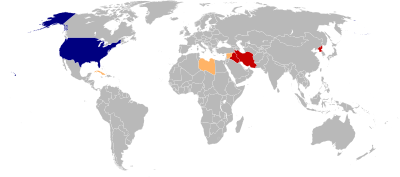In his State of the Union Address on January 29, 2002, President George W. Bush introduced a term that would reverberate throughout the world and shape the geopolitical landscape of the early 21st century. This term, the “axis of evil,” referred to Iraq, Iran, and North Korea, and was used to highlight these nations’ alleged support for terrorism and pursuit of weapons of mass destruction.
The use of the term “axis of evil” by President Bush sparked intense debate and controversy. Supporters argued that it accurately reflected the threats posed by these countries, while critics argued that it oversimplified complex geopolitical issues and could potentially lead to further tensions and conflicts.
President Bush’s decision to label these countries as part of an “axis of evil” was based on several factors. Firstly, Iraq, Iran, and North Korea were seen as rogue states that posed significant security risks to the United States and its allies. The Bush administration believed that these nations were actively pursuing nuclear weapons capabilities and supporting terrorist organizations.
At the time, the United States was still reeling from the 9/11 terrorist attacks, and there was a heightened sense of urgency to address potential threats to national security. President Bush’s speech aimed to rally support for his administration’s efforts to combat terrorism and prevent the proliferation of weapons of mass destruction.
However, critics argued that the term “axis of evil” was an oversimplification of complex geopolitical dynamics. They pointed out that Iraq, Iran, and North Korea had distinct motivations and agendas, and grouping them together under one label ignored these nuances. Additionally, critics argued that the use of such inflammatory language could further isolate these countries and hinder diplomatic efforts.
The consequences of President Bush’s use of the term “axis of evil” were significant. The speech solidified the United States’ hardline stance on these nations and set the stage for future military interventions and conflicts. In 2003, the United States invaded Iraq, citing its alleged possession of weapons of mass destruction as a primary justification.
However, subsequent investigations revealed that Iraq did not possess the weapons that had been used to justify the invasion. This revelation further fueled criticism of the Bush administration’s decision to use the term “axis of evil” and its subsequent actions.
The term “axis of evil” also had broader implications for international relations. It strained diplomatic relations between the United States and these countries, making it more challenging to engage in meaningful dialogue and diplomacy. The tensions created by the “axis of evil” label continue to shape international relations to this day.
It is important to note that the term “axis of evil” coined by President Bush in 2002 is not without its critics and controversies. Many argue that it oversimplified complex geopolitical issues and contributed to a climate of fear and mistrust. Others argue that it was a necessary step in addressing legitimate security concerns.
Regardless of one’s perspective, the term “axis of evil” remains a significant part of modern history. It represents a turning point in U.S. foreign policy and serves as a reminder of the complexities and challenges of navigating the global stage.
SEO Excerpt:
In his State of the Union Address on January 29, 2002, President George W. Bush referred to Iraq, Iran, and North Korea as the “axis of evil.” This controversial term was used to describe these nations’ alleged support for terrorism and pursuit of weapons of mass destruction. Bush’s speech signified a hardline stance in U.S. foreign policy and played a significant role in shaping the geopolitical landscape in the early 21st century.
External References:
- White House – State of the Union Address (2002)
- BBC – The ‘Axis of Evil’ Speech (2002)
- Council on Foreign Relations – Axis of Evil (2002)

